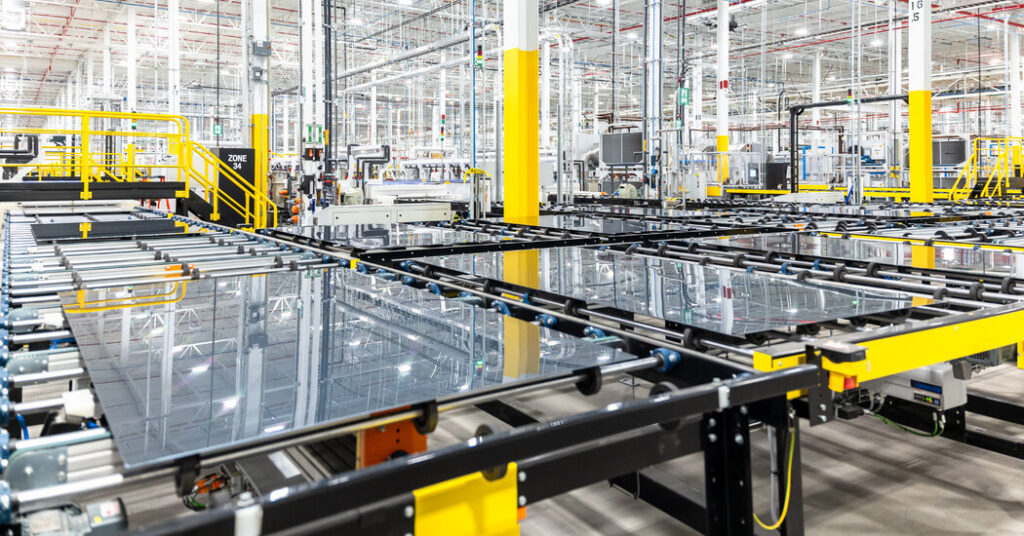The Biden administration has begun pumping greater than $2 trillion into U.S. factories and infrastructure, investing huge sums in an effort to strengthen U.S. business and struggle local weather change.
However the effort faces a well-known risk: a wave of low-priced merchandise from China. That is drawing the eye of President Biden and his aides, who’re contemplating new protectionist measures to make sure U.S. business can compete with Beijing.
As U.S. factories churn to supply electrical automobiles, semiconductors and photo voltaic panels, China is flooding the market with related items, usually at considerably decrease costs than U.S. opponents. An identical inflow can be hitting the European market.
U.S. executives and officers declare China’s actions violate world commerce guidelines. The considerations are resulting in new calls in America and Europe for greater tariffs on Chinese language imports, probably escalating the already contentious financial relationship between China and the West.
The Chinese language imports mirror a surge that undermined the Obama administration’s efforts to spice up home photo voltaic manufacturing after the 2008 monetary disaster and compelled some U.S. startups out of enterprise. The federal government retaliated with tariffs on photo voltaic tools from China, sparking a dispute on the World Commerce Group.
Some Biden officers are involved that Chinese language merchandise may as soon as once more threaten the survival of U.S. factories because the administration spends large sums to spice up home manufacturing. It seems possible that administration officers will enhance tariffs on electrical automobiles and different strategic items from China as a part of a assessment of tariffs former President Donald J. Trump imposed on China 4 years in the past, in response to folks conversant in the matter . That assessment, which has been underway since Mr. Biden took workplace, may lastly be accomplished within the coming months.
Congress can be calling for extra safety. In a Jan. 5 letter to the Biden administration, bipartisan members of a Home committee expressed concern about China flooding the US with semiconductors. Lawmakers questioned whether or not the federal government may impose a brand new “part” tariff that might tax a chip imported into one other completed product.
That adopted a November letter through which members of the identical committee suggested the Biden administration to think about a brand new commerce case over China’s electrical automobile subsidies, which may end in extra tariffs on vehicles.
U.S. Commerce Consultant Katherine Tai advised lawmakers she shared her considerations about Chinese language practices within the electrical automobile business, in response to a Jan. 4 letter shared with The New York Occasions. Ms. Tai advised the committee that the administration ought to “work with U.S. firms and labor unions to determine and deploy extra measures to assist overcome Chinese language state-led industrial focusing on on this sector.”
The USA has maintained tariffs on lots of of billions of {dollars} of Chinese language merchandise over the previous 5 years, seeing this as a solution to offset Beijing’s capacity to undercut American producers by promoting cheaper merchandise in the US. Mr. Biden has sought to additional assist American firms with billions in subsidies geared toward boosting U.S. manufacturing of fresh power expertise equivalent to photo voltaic panels and electrical automobiles, together with semiconductors.
But Chinese language industrial coverage spending nonetheless far exceeds that of the US. Confronted with an financial slowdown and a gradual bursting of the actual property bubble, the Chinese language authorities has not too long ago redoubled its efforts to advertise exports and help the manufacturing facility sector.
Beijing is principally specializing in investments in high-tech merchandise of strategic significance, equivalent to electrical automobiles and semiconductors, stated Ilaria Mazzocco, a senior fellow in Chinese language enterprise and economics on the Heart for Strategic and Worldwide Research, a Washington suppose tank.
“These are the kinds of industries the remainder of the world desires too,” she stated.
A part of China’s success comes from its bigger market – which provides Chinese language firms the size and skill to hone their merchandise – together with its huge pool of proficient engineers. For instance, China bought about 6.7 million all-electric automobiles final 12 months, in comparison with about 1.2 million in the US.
The Chinese language authorities has stated it competes pretty and described U.S. commerce measures as protectionist.
However Wendy Cutler, vp of the Asia Society Coverage Institute and a former commerce negotiator, stated China’s clear power and semiconductor industries have acquired a number of state help, within the type of tax breaks, entry to cheaper power and fairness injections.
“The record goes on,” she stated. “If Chinese language firms use a majority of these programs, it can solely result in overcapacity.”
In the US, when provide of photo voltaic panels exceeds demand, factories shut down their strains, lay off employees and attempt to realign capability, stated Michael Carr, govt director of the Photo voltaic Vitality Producers for America Coalition, representing the USA. established photo voltaic power producers.
“It does not work that approach in China,” he stated. “They simply saved constructing and constructing and constructing.”
In accordance with analysts at Wooden Mackenzie, an power analysis agency, China invested greater than $130 billion within the photo voltaic sector final 12 months and is positioned to deliver sufficient wafer, cell and panel capability on-line this 12 months to fulfill annual world demand to be met till 2032.
Late final month, two American firms filed a authorized problem to a short lived moratorium the Biden administration had positioned on tariffs on imported photo voltaic panels.
China’s heavy investments in semiconductors, together with a brand new $40 billion fund to help the business, are additionally worrying firms investing in new U.S. chip amenities.
China accounts for a small share of world chip manufacturing — solely about 7 % in 2022. However consultants say the nation is spending extra on its semiconductor business than the US and Europe mixed, and will develop into the world’s largest chipmaker. within the subsequent decade.
Dan Hutcheson, the vice chairman of analysis agency TechInsights, stated the worry was that China would do for semiconductors what it did for transport, photo voltaic cells or metal: construct up extra capability after which put international opponents out of enterprise.
“It is a authentic worry as a result of the weak point of Western firms is that they must be worthwhile,” he stated.
The USA can – and does – impose tariffs on Chinese language exports which are unfairly backed or bought into the U.S. marketplace for lower than they price to supply. This month the nation imposed tariffs of greater than 120 % on Chinese language metal.
However even when Chinese language items are blocked from the US, they will stream to different international locations. That pushes world costs to ranges at which U.S. firms say they can not compete, and pushes U.S. firms out of international markets, decreasing their revenues and competitiveness.
Some say the US ought to merely embrace low-cost Chinese language-made photo voltaic panels and older chips, quite than impose tariffs that elevate prices for American customers and factories that use imported inputs.
Scott Lincicome, a commerce knowledgeable on the libertarian Cato Institute, stated it did not make financial sense for the US to attempt to outdo China, particularly on non-military-related items.
“Is the precise reply that we make our personal grants? Or ought to we be a greater economist and say, ‘Really, we let international governments subsidize our consumption like loopy, we do not actually care’?” stated Mr. Lincicome.
However most officers in Washington now see China’s dominance in key markets as a major danger, given rising tensions between the international locations and China’s imposition of sure export bans. China produces about 80 % of the world’s photo voltaic panels, virtually 60 % of electrical automobiles and greater than 80 % of electrical automobile batteries.
The common worth for an electrical automobile in China is about $28,000, in comparison with about $47,500 in the US, in response to Dunne Insights, an electrical automobile market analysis agency. Within the fourth quarter of final 12 months, Chinese language automobile producer BYD delivered extra electrical automobiles than Tesla for the primary time.
Chinese language electrical automobiles have develop into more and more common in Europe, prompting the European Union to launch an investigation into unlawful subsidies. Thus far, Chinese language electrical automobiles haven’t gained a foothold in the US, which imposes excessive tariffs on these imports.
As a part of the local weather regulation that Mr. Biden signed in 2022, consumers of electrical automobiles which are primarily sourced and assembled in the US quite than China will even obtain profitable tax breaks. Nonetheless, some officers fear that Chinese language automobiles are usually a lot cheaper than American options that buyers may select to purchase them anyway.
Keith Bradsher contributed reporting from Shanghai.


